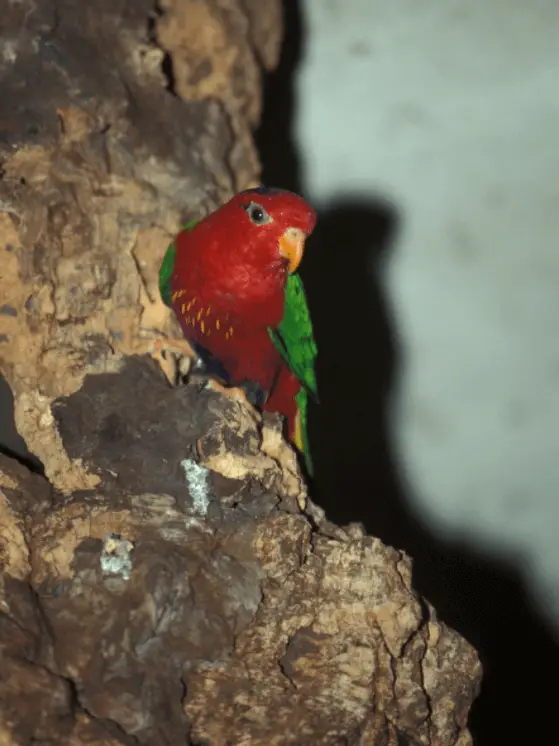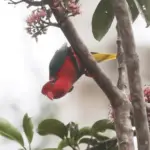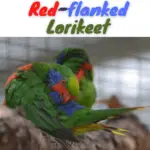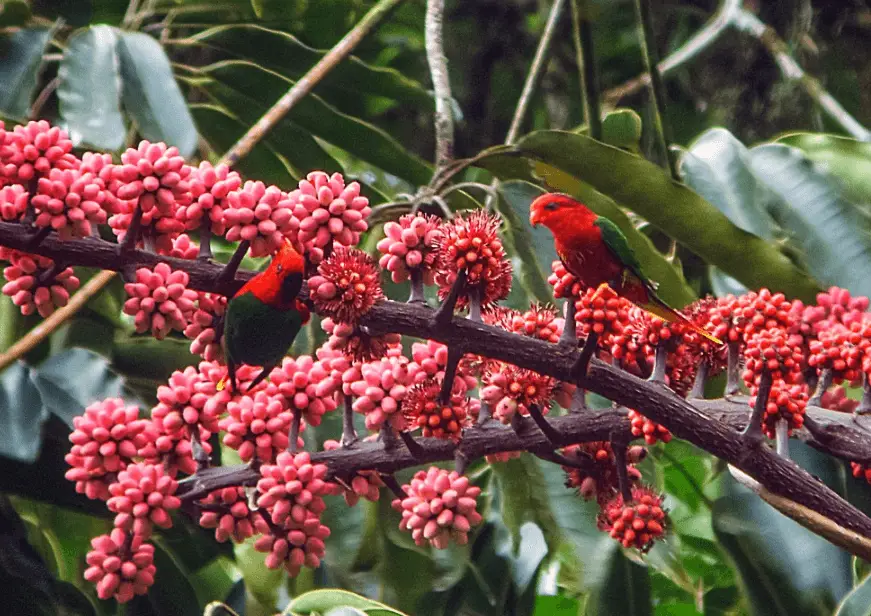
Fairy Lorikeet 18–19 cm; 24–35 g. Red on head, nape, and underparts except for a purplish-black patch on the mid-to hind crown, thin yellow streaks on breast, dusky thighs;
wings green with red and green underwing coverts and dark flight feathers; rump patch dull blue, sometimes washed green; upper tail-coverts and proximal half of upper tail green, distal half red becoming yellow, underside yellow; and bill legs orange-red.
Fairy Lorikeet Female has yellow patches on the sides of the rump. Immature has green in dark crown patch and thighs, and on breast, the yellow band across the underside of flight feathers.
Race Rothschild has a crown patch joined to the rear edge of dark supercilium, a large green breast patch, a dull purplish belly, and no blue rump; the female is more extensively green below.
Systematics History
Editor’s Note: This article requires further editing work to merge existing content into the appropriate Subspecies sections. Please bear with us while this update takes place.
Populations of C & E New Guinea were formerly considered a separate race, Bella. Two subspecies were recognized.
Subspecies
Charmosynopsis pulchella rothschildi Scientific name definitions
Distribution
Charmosynopsis pulchella pulchella Scientific name definitions
Distribution
mountains from Vogelkop Peninsula E to the Huon Peninsula and SE New Guinea; recorded also in Fakfak Mts (Bomberai Peninsula, W New Guinea) (Gibbs 1994).
Distribution

Editor’s Note: Additional distribution information for this taxon can be found in the ‘Subspecies’ article above. In the future, we will develop a range-wide distribution article.
Habitat
Forest, forest edge, and secondary areas in lower hills and mid-montane areas, variably occurring at altitudes of 500–1800 m, sometimes in lowlands.
Movement
Fairy Lorikeets wander nomadically into lowlands at times, and their presence in one area of uplands is directly related to the flowering of Melicope.
Diet and Foraging
Fairy Lorikeet Feeds at canopy flowers presumably on pollen and nectar; large Melicope trees appear important, and inflorescences of Elaeocarpus and Syzygium.
Sounds and Vocal Behavior
Fairy Lorikeet Calls include a high-pitched “tsit” and a thriller “skreet”. During feeding and in flight, groups maintain contact using continuous twittering.
Breeding
Dec–Jan, Apr. Fairy Lorikeet Nest a hole excavated in the base of an epiphyte. In captivity: 1–2 eggs, size 18·9 mm × 16·2 mm (Harrison and Holyoak 1970); incubation apparently 25 days; nestling period c. 2 months.
Conservation Status
Not globally threatened. CITES II. Scarce in some areas, common in others, and locally abundant. Levels of trade, almost all out of Indonesia, are generally low.





















